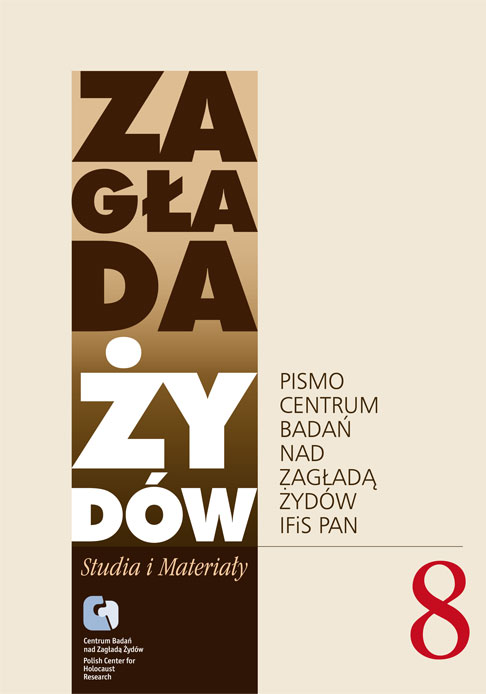O tym, co minęło, lecz nie zostało zapomniane: Badania archeologiczne na terenie byłego obozu zagłady w Treblince
Zagłada Żydów. Studia i Materiały, Nr 8 (2012), Strony: 83-118
Data zgłoszenia: 2020-10-27Data publikacji: 2012-12-02
 https://doi.org/10.32927/ZZSiM.628
https://doi.org/10.32927/ZZSiM.628
Abstrakt
Public impression of the Holocaust is unquestionably centred on knowledge about, and the image of, Auschwitz-Birkenau – the gas chambers, the crematoria, the systematic and industrialized killing of victims. Conversely, knowledge of the former extermination camp at Treblinka, which stands in stark contrast in terms of the visible evidence that survives pertaining to it, is less embedded in general public consciousness. As this paper argues, the contrasting level of knowledge about Auschwitz- Birkenau and Treblinka is centred upon the belief that physical evidence of the camps only survives when it is visible and above-ground. The perception of Treblinka as having been “destroyed” by the Nazis, and the belief that the bodies of all of the victims were cremated without trace, has resulted in a lack of investigation aimed at answering questions about the extent and nature of the camp, and the locations of mass graves and cremation pits. This paper discusses the evidence that demonstrates that traces of the camp do survive. It outlines how archival research and non-invasive archaeological survey has been used to re-evaluate the physical evidence pertaining to Treblinka in a way that respects Jewish Halacha Law. As well as facilitating spatial and temporal analysis of the former extermination camp, this survey has also revealed information about the cultural memory.
Słowa kluczowe
Treblinka , archeologia Zagłady , obóz zagłady , dowody rzeczowe , halacha
Licencja
Prawa autorskie (c) 2012 Autor&"Zagłada Żydów. Studia i Materiały"

Utwór dostępny jest na licencji Creative Commons Uznanie autorstwa 4.0 Międzynarodowe.
https://creativecommons.org/licenses/by/4.0
Czasopismo publikowane jest w standardzie Diamond Open Access na licencji CC-BY-4.0 Deed - Uznanie autorstwa 4.0 Międzynarodowa - Creative Commons
Inne teksty tego samego autora
- Caroline Sturdy Colls, Gone but not Forgotten: Archaeological approaches to the site of the former Treblinka Extermination Camp in Poland , Zagłada Żydów. Studia i Materiały: Nr Holocaust Studies and Materials (2013)
Podobne artykuły
- Marek Bem, Ci, którzy przeżyli Sobibór , Zagłada Żydów. Studia i Materiały: Nr 5 (2009)
- Grzegorz Rossoliński-Liebe, Ukraińska policja, nacjonalizm i zagłada Żydów w Galicji Wschodniej i na Wołyniu , Zagłada Żydów. Studia i Materiały: Nr 13 (2017)
- Stephan Stach, „Duch czasu wycisnął jednak na tej pracy swe piętno”. Historia Zagłady w badaniach Żydowskiego Instytutu Historycznego w okresie stalinowskim , Zagłada Żydów. Studia i Materiały: Nr 13 (2017)
- Dionizjusz Czubala, Pamięć Zagłady w narracji folklorystycznej , Zagłada Żydów. Studia i Materiały: Nr 13 (2017)
- Jacek Leociak, Cenzor na straży Kościoła. Ocenzurowany pamiętnik Krystyny Modrzewskiej , Zagłada Żydów. Studia i Materiały: Nr 5 (2009)
- Paweł Kosewski, Pamięć o Holokauście w kinie fabularnym (analiza retrospekcji filmowej, na podstawie filmów Pasażerka i The Pawnbroker) , Zagłada Żydów. Studia i Materiały: Nr 5 (2009)
- Barbara Engelking, Jan Górnicki (Ber Oszer Weisbaum), Notatki , Zagłada Żydów. Studia i Materiały: Nr 8 (2012)
- Przemysław Czapliński, The Auschwitz Virus , Zagłada Żydów. Studia i Materiały: Nr Holocaust Studies and Materials (2017)
- Bożena Szaynok, „Tuż po Zagładzie”. Kościół wobec problematyki żydowskiej (VII 1944–VII 1946) , Zagłada Żydów. Studia i Materiały: Nr 5 (2009)
- Amos Goldberg, Głos ofiary i estetyka melodramatu w historii , Zagłada Żydów. Studia i Materiały: Nr 5 (2009)
<< < 16 17 18 19 20 21 22 23 24 25 26 27 28 29 30 31 32 33 34 35 36 37 38 39 40 41 42 > >>
Możesz również Rozpocznij zaawansowane wyszukiwanie podobieństw dla tego artykułu.
 English
English
 Język Polski
Język Polski



 https://orcid.org/0000-0003-2942-6219
https://orcid.org/0000-0003-2942-6219

